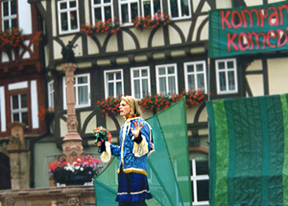
The term Commedia dell’Arte was not used during the renaissance. It was used for the first time, the way we do today, in the eighteen century by Luigi Riccoboni in his book Histoire du Theatre Italien from 1728. At that time Commedia dell’Arte was about to get decadent and Carlo Goldoni was just about to take the masks of the actors and write scripted comedies for them.
Earlier it was called Commedia Improviso – improvised comedy; Commedia alla Maschera – comedy in mask; Commedia a Soggetto – Comedy an a given subject; Commedia Mercenaria – Commercial Comedy; Commedia Braccia – Comedy off the Top of one’s Head; Commedia degli Zanni – Comedy with Zanni or simply Commedia Italiana. The less fortunate companies that were allot to play in the streets were often talked about as Charaltano shows, by the priests who described them in order to have them forbidden.

The traditional translation of Commedia dell’Arte is comedian to profession, or art. Nicoll Allardyce proposes comedy by skill or that arte would stand for “special dexterity” or “unique talent”. Anyhow the word “arte” should be interpreted as “craft” as in “artisan” rather than as “art” as in “artist”.
According to Dario Fo and Benedetto Croce Commedia dell’Arte is a term that defines the professional companies that had a license by the prince or the authorities to play in a specific town, where the term was actually written on their contract. Everyone needed naturally a permission by the authorities to be allowed to play publicly, and the authorities held strict control when, where, and what was played.
Dario Fo also claims that the word “arte” was, since the Middle Ages, another word for guild or fraternity. The word then was used in transferred sense by Luigi Riccoboni when he created, or named the genre.
In that way the term is more to be regarded as a union or rather a guild, that an artistic phenomenon. Their aim was off course to care for the member’s interests by going together when dealing with the authorities and reduce the competition by excluding companies that were not members. Isn’t that just like, at least the Swedish, actors unions today?
This may have been the first “fringe” theatre groups in Europe. In any case it is the first time in history that actors are enforced, or had the possibility, to negotiate contracts and at the same time become entrepreneurs. Mobility, virtuosity and swiftness to find new markets, or flexibility and competence as it is called today, became essential qualification for a company to survive.
See also:
The roots to all western popular comedy
What is a mask?
Var är Boken (Where’s the Book)